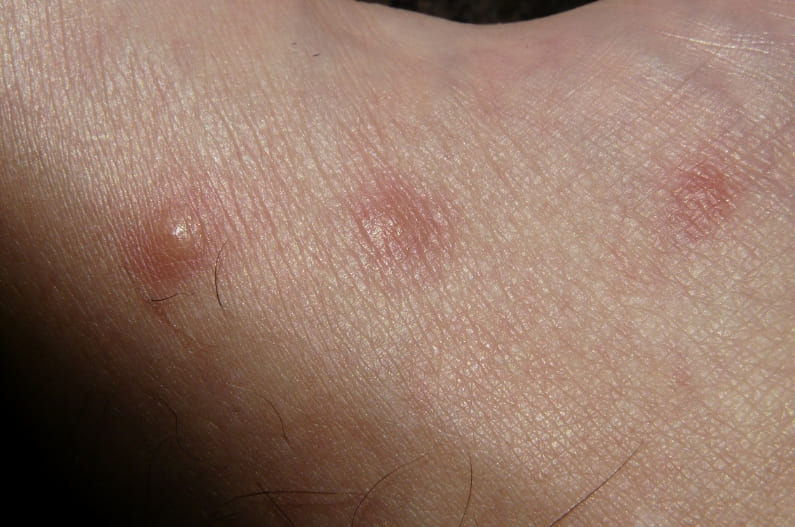Pustules on the skin have various causes. An allergy or skin fungus is one possible cause. Pus blisters can also be an indication of the rare skin disease psoriasis pustulosa.
How do I recognize pustular psoriasis?
What are the possible causes of this special form of psoriasis?
How are pus-filled blisters treated?
We will give you an overview of all the important information about psoriasis pustulosa.
Psoriasis pustulosa: A rare and dangerous special form of psoriasis
Psoriasis pustulosa is a special form of psoriasis and affects less than five percent of psoriasis patients.
Characteristic for this form of psoriasis are pus-filled pustules which form directly on the scales of the inflamed skin surface. The pus in the pustules is not infectious, i.e. not contagious, as it consists mainly of neutrophil granulocytes (defense cells of the immune system).
In contrast to other types of psoriasis, there is no sign of heredity in psoriasis pustulosa.
Symptoms of psoriasis pustulosa
The symptoms of psoriasis pustulosa differ greatly from the classic picture of psoriasis. This rare form of psoriasis is characterized by innumerable, mostly grouped pustule. These pus blisters sit on the inflamed skin areas (plaques) and are often associated with severe pain and itching.
Affected body parts in psoriasis pustulosa:
- Palms of the hands,
- Soles of the feet,
- Bed of nails or
- The whole body.
Even if the pustules are filled with pus, there is no danger of infection. The fluid is made up of defense cells from the body’s own immune system. The pus is therefore germ-free.
Another special feature of this form of psoriasis is that the typical scale is sometimes completely absent. They are practically replaced by the blisters. As a rule, however, there is only reduced psoriasis.
Sub-forms of pustular psoriasis
Doctors speak of localized pustular psoriasis when the vesicles are restricted to the hands and feet. In a generalized form, however, pus-filled pustules appear all over the body.
Depending on the occurrence of the pustules, pustular psoriasis is divided into five sub-forms with individual symptoms.
Pustular psoriasis palmoplantaris – type Barber
Pustulosa palmoplantaris psoriasis, also known as type Barber, is very rare and occurs only on the palms of the hands and soles of the feet.
The initially yellowish pustules change to dry, brownish crusts. The surrounding skin is sore and cracks in the skin can occur.
The symptoms are often associated with excruciating pain for those affected and consequently with considerable restrictions in their everyday life. For example, grasping objects or walking is torture.
Smokers in particular are affected by this form of pustular psoriasis.
Acrodermatitis supprativa – type Halopeau
In this subtype of pustular psoriasis, the nail bed and the skin on the fingertips are affected.
In addition to pus-filled blisters, redness and inflammation can also occur. If psoriasis is not treated, the nail bed is sometimes completely destroyed and in severe cases, even irreparable nail loss occurs.
Compared to the other subtypes, acrodermatitis supprativa does not progress in relapses. Instead, it progresses slowly.
Psoriasis pustulatione
Pustular pustulatione is often triggered by classic psoriasis vulgaris, usually within an acute inflammatory phase. Pus blisters form in batches in the marginal area on the already existing plaques.
Pustular psoriasis generalisata – Zumbusch type
The Zumbusch type is the most severe form of pustular psoriasis.
In this form, the entire body of the affected person is affected by purulent blisters over a large area. The pustules often flow into each other and form so-called “pus lakes”.
The overall health of the patient deteriorates considerably. Symptoms of pustular psoriasis pustulosa generalisata:
- swelling of the lymph nodes,
- high fever,
- joint pain and/or
- muscle stiffening.
In addition, the risk of water retention inside the body (edema) increases rapidly.
Pustulosa psoriasis Zumbusch type is rare, but in this form, it is also life-threatening and therefore requires immediate treatment in a dermatological clinic.
Impetigo herpetiformis
Impetigo herpetiformis, a minor form of pustular psoriasis generalisata, only occurs in pregnant women. This disease is very dangerous for both the pregnant woman and the unborn child.
The affected women suffer from a pronounced feeling of illness, fever and/or diarrhea. In addition, the function of the placenta can also be severely restricted. The necessary supply of nutrients to the unborn child can sometimes no longer be provided adequately.
Psoriasis pustulosa – treatment options and tips
Treatment of pustular psoriasis: local and/or systemic
Depending on the manifestation, different forms of therapy are possible to alleviate the symptoms and complaints. Both local and systemic (internal) treatment measures are used.
Affected areas of type Halopeau and type Barber can in most cases be successfully treated locally in the form of creams or ointments. Preparations with the active agents ciclosporin and methotrexate have proven to be particularly effective.
If the Barber type is manifested extensively and over a large area, systemic therapy in the form of injections or tablets is often required.
Pustular psoriasis pustulatione and the generalized form also require systemic treatment in most cases.
In the generalized form, systemic treatment is often combined with PUVA therapy (psoralen + UVA).
Helpful tips for those affected:
In addition to the listed treatment options, there are other recommendations to reduce or not aggravate the symptoms of the disease.
- As a person affected by pustular psoriasis, you should make sure that you lead a healthy lifestyle and avoid alcohol consumption and smoking. Smoking is considered to be the trigger of pustular psoriasis pustulosa palmoplantaris (type Barber).
- The consumption of fatty fish (e.g. mackerel or salmon) is advisable. It contains valuable omega-3 fatty acids which have an anti-inflammatory effect.
- Doctors recommend eating enough fruit, vegetables and wholemeal products and making sure you maintain a healthy weight.
- Blood pressure-lowering preparations (e.g. ACE inhibitors, beta-blockers), as well as rheumatism medication, should be avoided if possible, as these can worsen the symptoms of pustular psoriasis.
- Many sufferers also use the household remedy aloe vera because of its anti-inflammatory effect.
Conclusion: Psoriasis pustulosa – if your skin is marked by small pustules
Even if pustular psoriasis is rather rare, it is often all the more stressful for those affected. Depending on its manifestation, this psoriasis can be very severe.
For patients, the disease not only represents an enormous visual burden but is also associated with pain that should not be underestimated and considerable restrictions in everyday life. For example, pustular psoriasis of the hands and feet (pustular psoriasis palmoplantaris) turns every day, necessary activities into constant torture.
In some cases or with some degrees of severity, this form of psoriasis can even be life-threatening for those who suffer from it. Therefore, immediate professional therapy is more than necessary.
The treatment options available today make it easier for those affected to manage psoriasis pustulosa and make life with this rare form of psoriasis more bearable, despite the severity of the disease.
Do you suffer from pustular psoriasis? We look forward to meeting you in our Facebook group as well.
Click here to find all the references
Sources:
Christophers, E.; Mrowietz, U. in Deutsches Ärzteblatt 1999; 96: A-2220-2226 [issue 36]; URL: https://www.aerzteblatt.de/archiv/18798. Access on 29.03.2019.

Bernd is one of the founders of Simply Psoriasis. He has been suffering from psoriasis for more than 20 years, but sees the chronic skin disease with more composure than a few years ago (which was a hard work). Nevertheless, he is very keen to make psoriasis easier and more socially accepted.









Last Comments